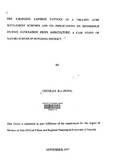| dc.description.abstract | More than 80 percent of kenyas population relies on small scale agriculture for their livelihood. This population is disproportionately located in rural areas and constitute the majority of the poor in Kenya. Experience has shown that traditional administrative approach in community development that was inherited from colonial era led to the economic structure where the rural are the majority and very poor. There has been a disharmony in identification of local requirements and planning needs and in identification, mobilization and allocation of local resources.
The end of reservation of white highlands as scheduled areas in 1960 opened up high potential land for African Settlement. The independent Kenyan government embarked on various programmes of allocating this land to Africans. The unpreparedness of the government to handle the process of land transfer could be seen in the haste, the number of many uncoordinated settlement programmes and the unviable financial packages that characterized the process.
Besides peasant and Yeoman settlement schemes, A million acre settlement scheme was the most publicised and the largest in terms of the acreage of land involved. A million acre scheme was initiated in 1962 to allow for purchase of 1 million acres of European mixed farms over a period of five years and transfer the land to African fanners. Other objectives of a million acre settlement scheme were economic, thus to create employment on the farms and generate sufficient income to the farmers. The architects of the programme came up with strategies that were universally applied to other settlement schemes such as land budget, annual expenditure and income, and loan repayment schedules.
Thirty years since the completion of the programme in 1966, the objectives of adequate income generation and creation of employment have not been achieved as most peasant farmers can no longer generate enough incomes from their fanning activities neither can farming absorb all the available labour in this regions leading to widespread poverty.
Based on the objectives stipulated during the settlement programme in 1962, this study identifies the various changes that have taken place in the settlement scheme and how farmers have responded to a rather dynamic situation hence coming up with their own methods of generating more income
While looking at the above changing scenario, the study adopts a sociological approach to poverty alleviation, that in order to impact a last solution to poverty, rural development should be understood in a wider perspective founded on the philosophy and principles that aim to ameliorate poverty and stimulate a process of long term change. The objectives should be concentrated on poverty alleviation, necessity for community participation and need to take account of multi-sectorial linkages in rural economy.
The study identified several changes which have taken place in the settlement scheme. They include an increase in population; a decline in average size of land available to a household and introduction of new crops and methods of generating more income. The study also identified factors that are beyond farmers control, but have a great influence on the amount of income earned from each farming activity. Such factors include product prices, methods of marketing and climatical.
Based on the finding of the research, several policy measures are recommended to encourage the development of fanners activities that have more potentials of raising
more income. Dairy farming, maize cultivation, Tobacco growing, and coffee planting are identified as some of the lucrative sources of income.
In conclusion, the study reveals that there exists enormous potential for agricultural improvement in Naitiri scheme and before turning to non-agricultural income generating activities, there should be an effort to move towards agricultural intensification and diversification supported by enabling national policies. | en_US |



